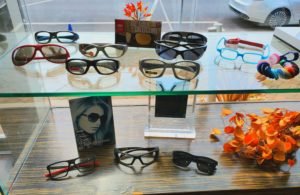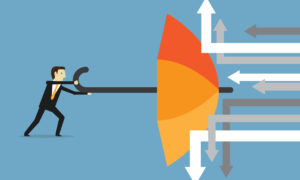
RecSpecs by Liberty Sports glasses on display in the practice window of Vittorio Mena OD, MS. He says that making it easy to find sports eyewear in your office, and educating patients about the need for them, is essential to boosting sales of these products.
Feb. 15, 2023
When it comes to protecting eyes during sports activities, eyecare professionals (ECPs) are in strong agreement that proper eye protection can reduce the number and severity of eye injuries.
Yet, when it comes to recommending proper protective sports eyewear, many are not proactively initiating the conversation with patients or parents, according to new research presented at the International Sports Vision Association (ISVA) Annual Conference.
Nearly 400 ECPs participated in the “Sports Eye Injuries & Protective Sports Eyewear” survey conducted by Jobson Research in conjunction with ISVA and Zyloware Eyewear. The survey was designed to understand ECPs’ experiences in treating sports-related eye injuries and gauge their knowledge and attitudes about sports protective eyewear, along with factors that influence their decision to recommend protective eyewear to their patients.
More than 40 percent of eye injuries happen every year during sports and recreational activities.1 About half (53 percent) of ECPs surveyed note that most sports-related eye injuries they treat are among teenagers (ages 13-19), followed by young adults (20’s), children (12 and under), adults (30-50) and older adults (50+). Asked to rank what sports-related eye injury they treat most often, about three in four (72 percent) cite corneal abrasions as the most common injury they see, followed by blunt trauma, detached retina and penetrating eye injuries.
Other Articles to Explore
“Sports that use a ball, puck, bat or racquet and/or have close aggressive play with intentional or unintentional body contact and collision are at high risk for eye injuries,” says ISVA Vice President, Membership Jennifer Stewart, OD.
Survey respondents say basketball (55 percent) and baseball (53 percent) are the sports that are the cause of most of the sports-related eye injuries they treat. About four in ten (39 percent) note they often treat eye injuries associated with racquet sports (i.e., tennis, pickleball and badminton) and flag or tackle football (36 percent). Soccer (33 percent), hockey (12 percent), water sports (9 percent) and lacrosse (7 percent) were other top athletic activities noted.
During eye examinations or other office visits, most ECPs say they are proactive in asking patients about the sports/leisure activities they participate in, yet only one in three (35 percent) report that the optometrist/ophthalmologist will initiate a conversation about protective sports eyewear and one in five (21 percent) say it’s an optical staff member. Four-in-10 say the subject is generally introduced by parents/guardians (24 percent) and patients (16 percent).
“Increased prevention efforts are needed to decrease sports- and recreation-related eye injuries among athletes of all age and skill levels,” says Dr. Stewart. “As eyecare professionals, we are in a unique position to help our patients avoid potential vision-threatening injuries before they happen,” she adds. More than 90 percent of sports- and recreation-related eye injuries can be prevented by using appropriate eye and facial protection.2
Appropriate Eye Protection
About nine-in-10 (89 percent) ECPs surveyed agree that everyday dress-wear eyeglasses and sunglasses don’t offer adequate protection to guard against potential eye injuries while playing sports, and that wearing protective sports eyewear is as important as putting on other protective gear such as helmets and pads (92 percent). A significant majority (81 percent) agree that all children need protective sports eyewear while playing sports regardless of whether they wear glasses or contact lenses. “Sports and recreation activities and equipment are associated with approximately one-fourth of all pediatric eye injuries2,” notes Dr. Stewart.
ASTM International, one of the largest voluntary standards developing organizations in the world, sets the standards that eye protection must meet to help prevent eye injuries in different sports. Each sport has a specific ASTM standard, which prescribes specific impact testing to best determine the eyewear’s ability to prevent an ocular injury in consideration of the unique elements of play and equipment associated with a particular sport.
Virtually all ECPs surveyed (97 percent) agree that it is important that protective sports eyewear meet the appropriate ASTM standard for specific sports. Yet, when asked how familiar they are with these standards, only three in ten (30 percent) are very familiar while half (50 percent) are somewhat familiar and 21 percent are unfamiliar. “Recommendations and requirements are different for every sport, and it is important that eyecare professionals are acquainted with the appropriate ASTM standard designation for the sport an athlete plays,” explains optical engineer Dale Pfriem, Physical Scientist and Principal of Protective Equipment Consulting Services, Cleveland, Ohio, and chairman of ASTM Subcommittee F08.57 on Eye Safety for Sports.
Barriers to Dispensing Protective Sports Eyewear
Of those ECPs surveyed who say their practice does not dispense protective sports eyewear, about one-in-five (19 percent) say they find protective sports eyewear to be a difficult sell to parents. Six-in-10 (62 percent) say cost is the top reason patients give them for not wanting protective sports eyewear, while 44 percent say a patients’ insurance plan is another significant reason patients give them for not wanting protective sports eyewear.
“In the blink of an eye, an athlete can fall victim to a catastrophic eye injury that can affect his/her vision and eye health for years to come,” says Dr. Stewart. “While cost may be a factor for some, it’s imperative we educate parents, teachers, school nurses, coaches and athletes of all ages about the risks of not wearing proper protective eyewear during sports activities and encourage them to make this important equipment investment to protect their eyes.”
ISVA offers Protect. Prevent. Play., an educational resource that includes information about types of sports-related eye trauma, what to do (and not do) following an eye injury, along with important information about selecting the proper protective eyewear for the sport(s) you play. It can be found on the ISVA website at https://www.sportsvision.pro/athletes/protectpreventplay/, in addition to a downloadable PDF practitioners can post on their websites or print for distribution in their offices.
To download a copy of the “Sports Eye Injuries & Protective Sports Eyewear report, visit https://www.sportsvision.pro/athletes/protectpreventplay/sports-eye-survey/
References
- “Eye Injury Prevention,” American Academy of Ophthalmology, https://www.aao.org/eye-health/tips-prevention/preventing-injuries. Accessed 12/22/22
- Miller, K et al. Pediatric Sports- and Recreation-Related Eye Injuries Treated in US Emergency Departments, Pediatrics, February 2018 https://pediatrics.aappublications.org/content/141/2/e20173083

























